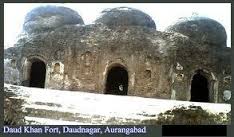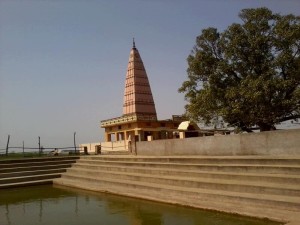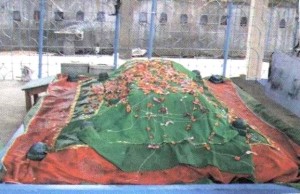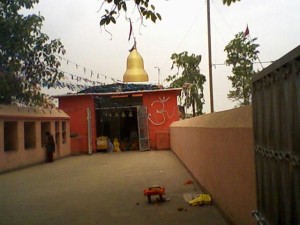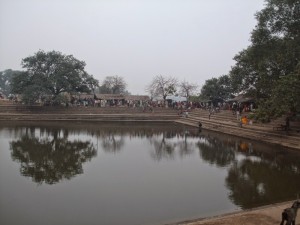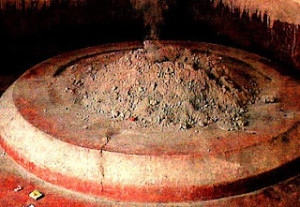AURANGABAD DISTRICT
Aurangabad got its name from one of the kings of the Mughal dynasty, Aurangzeb.Situated on the bank of river Adari. The history of Aurangabad is a part of history of the ancient Magadha which included the undivided district of Patna and Gaya .Three-fourth of India’s early history is the history of Magadha and the area which forms the present district of Aurangabad was a proud sharer of this glory .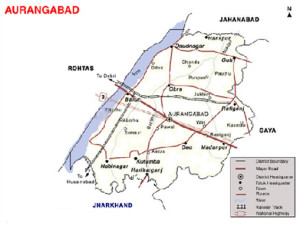
After downfall of Mughal Empire, the area came under control of zamindars of Deo, Kutumba, Mali, Pawai, Chandrgarh and Siris.
District of Gaya was separated from Patna District, and Aurangabad was made Sub Division in the year 1865 under Gaya District.The district of Aurangabad was separated on 26.01.1973. Till 1991 there was only on Sub-division in Aurangabad district. That was Aurangabad Sadar. On 31.03.1991, one other Sub-Division namely Daudnagar was created.
How To Reach
By Air (airport):-
Nearest airport is Gaya airport about 67 km away.
By Rail :-
Grand chord Line passes through the middle of this district.The nearest Railway Station is Anugrah Narayan Road (AUBR) situated on Grand Chord line about 13 kilometers from the District headquarter of Mughalsarai Division under ECR railway Zone.
By Road:-
Famous Grand Trunk Road (NH – 2), starting from Kabul in Afghanistan and ends at Calcutta in West Bengal, built by Sher Shah Suri crosses through Aurangabad.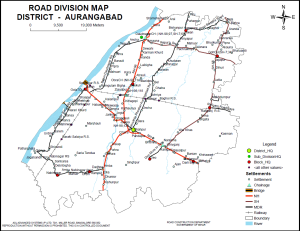
NH-98 SH-7,68 other roads-Nabinagar Barun Rd, Barun Daudnagar Rd,Pachrukhiya Pheshar Aurangabad Rd, Amba Nabinagar Rd,Piroo Bantara Rd,Deo more to Deo, Rafiganj road Gaya.
Popular tourist destinations
AURANGABAD BLOCK
Rampura:- The KP Jayaswal Research Institute, during in the course of its Archaeological Explorations brought to light the site period Early medieval. Kariawan:- The KP Jayaswal Research Institute, during in the course of its Archaeological Explorations brought to light the site period Shunga. Biseni:- The KP Jayaswal Research Institute, during in the course of its Archaeological Explorations brought to light the site period NBPW phase. Naugarh:- The KP Jayaswal Research Institute, during in the course of its Archaeological Explorations brought to light the site period NBPW phase. Aura:- The KP Jayaswal Research Institute, during in the course of its Archaeological Explorations brought to light the site period Shunga.
Pawai:- It is situated about 9 km west- south of Aurangabad on NH – 98.There are remains of old fort of Zamindar, whose princes, said to be migrated from Rajputana, Rajasthan,played a crucial role during the medieval and modern periods of history of Aurangabad .A visit to these places will prove to be highly adventurous for enthusiastic archaeologists.Over the passing years, the place became the playground of King Narayan Sing and some unsung heroes of The Revolt of 1857.The rebellious character of the zamindars of Siris,Kutumba and Pawai,is the proud-preserve in the history of this area.The first rebellion against the British authority belongs to Raja Narayan Singh of Riyasat Pawai,Whose forefathers said to be the descendants of Prithviraj Chauhan.The veteran freedom fighter Veer Kunwar Singh had his personal relationship in the family of Deo State .Some people say his Sasural was in that family . A joint army of all the Rajputs led by the men of Raja Narayan Singh started their towards Jagdishpur to help Veer Kunwar Singh during the year 1857 .He had also support of Raja Chet Singh of Varanasi,Pitambar Singh of Tekari and Kuli Khan of Sasaram . A ferocious battle took place at both the bank of river Sone, where thousands of Britishers and soldiers of Raja Narayan Singh were killed. The Sepoy Mutiny of Danapur and Benaras created Commotion in the whole area .It remained for the whole year of 1857 .In the next year, the British Government took measures to tighten their grip over administration.
According to Jayaswal Research Institute Archaeological Explorations this site belongs to Kushan period.
Salimpur Yogi Bigha (Kurma):- The KP Jayaswal Research Institute, during in the course of its Archaeological Explorations brought to light the site period NBPW phase. Khaira Bind:- The KP Jayaswal Research Institute, during in the course of its Archaeological Explorations brought to light the site period NBPW phase. Yari:- The KP Jayaswal Research Institute, during in the course of its Archaeological Explorations brought to light the site period Early medieval. Kapasiya:- The KP Jayaswal Research Institute, during in the course of its Archaeological Explorations brought to light the site period Late medieval. Jamhor Dumohan:- The KP Jayaswal Research Institute, during in the course of its Archaeological Explorations brought to light the site period Early medieval.
Mali :– It is situated about 21 km west- south of Aurangabad .There are remains of old forts of Zamindar, whose princes, said to be migrated from Rajputana, Rajasthan,played a crucial role during the medieval and modern periods of history of Aurangabad
Jamhor :- The site is on the bank of confluence of river Punpun and Batre. The river is supposed to be as pious as the Falgu river in Gaya to give mukti to dead ancestors of the Hindus specially those souls which have become Pisach after death. Before the period of Shard navratra , people take bath at this place and give Pind and Dan for mukti of those dead souls, who might not have got re-birth.
It is also in mythology that demon Jambh was killed by Indra at this place.
Cattle fair is organised here on Basant panchmi and Kartik purnima.
Syed Shah Suleman:-
Quadri R.A
Manawwara Sharif:–
Peeru:-
Gulshan E Quadria(Peeru):–
Sahab E Sajjada :Syed Shah Zahir Alam Quadri mada zillahul aali
NABINAGAR BLOCK
Chandra Garh:- It is situated about 43 km west- south of Aurangabad and 5 km south -west of Nabinagar.There are remains of old fort of Zamindar, whose princes, said to be migrated from Rajputana, Rajasthan,played a crucial role during the medieval and modern periods of history of Aurangabad .A visit to these places will prove to be highly adventurous for enthusiastic archaeologists.
According to Jayaswal Research Institute Archaeological Explorations this site belongs to Late medieval period.
Nabinagar:– The KP Jayaswal Research Institute, during in the course of its Archaeological Explorations brought to light the site period Medieval.
Sun Temple (Nabinagar):– The sun temple is constructed nearly 1922 but image established in the temple belongs to Pala Period , discovered in a big ancient tank during construction of bundh of tank for irrigation purpose.
Ramnagar garh:– The KP Jayaswal Research Institute, during in the course of its Archaeological Explorations brought to light the site period Medieval. Saratu Garh:- The KP Jayaswal Research Institute, during in the course of its Archaeological Explorations brought to light the site period Early medieval. Urdana:- The KP Jayaswal Research Institute, during in the course of its Archaeological Explorations brought to light the site period Medieval. Burhiban:– The KP Jayaswal Research Institute, during in the course of its Archaeological Explorations brought to light the site period Medieval. Khambha:- The KP Jayaswal Research Institute, during in the course of its Archaeological Explorations brought to light the site period Medieval. Babhandih:- The KP Jayaswal Research Institute, during in the course of its Archaeological Explorations brought to light the site period Medievla. Sonaura:- The KP Jayaswal Research Institute, during in the course of its Archaeological Explorations brought to light the site period Medieval. Mahuanw:– The KP Jayaswal Research Institute, during in the course of its Archaeological Explorations brought to light the site period Medieval. Barem:- The KP Jayaswal Research Institute, during in the course of its Archaeological Explorations brought to light the site period Early medieval. Kanker:- The KP Jayaswal Research Institute, during in the course of its Archaeological Explorations brought to light the site period Early medieval. Charan Mahadeva:- The KP Jayaswal Research Institute, during in the course of its Archaeological Explorations brought to light the site period Medieval. Rahara:- The KP Jayaswal Research Institute, during in the course of its Archaeological Explorations brought to light the site period Medieval. Simari Dhamani:– The KP Jayaswal Research Institute, during in the course of its Archaeological Explorations brought to light the site period Medieval. Kerka:- The KP Jayaswal Research Institute, during in the course of its Archaeological Explorations brought to light the site period Early medieval. Dhundhua:- The KP Jayaswal Research Institute, during in the course of its Archaeological Explorations brought to light the site period Early medieval. Kol manjhauli:- The KP Jayaswal Research Institute, during in the course of its Archaeological Explorations brought to light the site period Early medieval.
BARUN BLOCK
Sun Temple (Kharjama):- The villager have erected the Sun Temple following a divine order of an unknown Sadhu in year 1983-84.
Barauligarh (Pipra):- The KP Jayaswal Research Institute, during in the course of its Archaeological Explorations brought to light the site period Early medieval. Rampur (Pithanwan):- The KP Jayaswal Research Institute, during in the course of its Archaeological Explorations brought to light the site period Early medieval. Dhangachi (Rampur):- The KP Jayaswal Research Institute, during in the course of its Archaeological Explorations brought to light the site period Early medieval. Nadiain:- The KP Jayaswal Research Institute, during in the course of its Archaeological Explorations brought to light the site period Early medieval. Narari Khurd:- The KP Jayaswal Research Institute, during in the course of its Archaeological Explorations brought to light the site period Early medieval. Siris (Bhupatpur):- It is situated about 17 km west – north of Aurangabad on NH-2. Siris was a pargana during the rule of Sher Shah and the Mughal Empire. . Siris also houses a mosque, which was built during the rule of Aurangzeb.
According to Jayaswal Research Institute Archaeological Explorations this site belongs to Early medieval period.
Baghtarpa:- The KP Jayaswal Research Institute, during in the course of its Archaeological Explorations brought to light the site period Medieval. Sheikhpura Garh:- The KP Jayaswal Research Institute, during in the course of its Archaeological Explorations brought to light the site period Early medieval. Pipra:- The KP Jayaswal Research Institute, during in the course of its Archaeological Explorations brought to light the site period Early medieval.
RAFIGANJ BLOCK
Barappa:- The KP Jayaswal Research Institute, during in the course of its Archaeological Explorations brought to light the site period Early medieval. Dugul:- The KP Jayaswal Research Institute, during in the course of its Archaeological Explorations brought to light the site period Early medieval. Chaubara Bargaon:- The KP Jayaswal Research Institute, during in the course of its Archaeological Explorations brought to light the site period Early medieval. Kasama:- The KP Jayaswal Research Institute, during in the course of its Archaeological Explorations brought to light the site period Early medieval. Ourama:- The KP Jayaswal Research Institute, during in the course of its Archaeological Explorations brought to light the site period Early medieval. Salempur Parrahi:- The KP Jayaswal Research Institute, during in the course of its Archaeological Explorations brought to light the site period Early medieval. Charkupa:- The KP Jayaswal Research Institute, during in the course of its Archaeological Explorations brought to light the site period Early medieval. Charkawan:- The KP Jayaswal Research Institute, during in the course of its Archaeological Explorations brought to light the site period Early medieval. Bhatkuraha:– The KP Jayaswal Research Institute, during in the course of its Archaeological Explorations brought to light the site period Late medieval. Lahas:- The KP Jayaswal Research Institute, during in the course of its Archaeological Explorations brought to light the site period Medieval. Sonbarsha:- The KP Jayaswal Research Institute, during in the course of its Archaeological Explorations brought to light the site period Early medieval. Simwan:- The KP Jayaswal Research Institute, during in the course of its Archaeological Explorations brought to light the site period Early medieval. Chitrasari:-nThe KP Jayaswal Research Institute, during in the course of its Archaeological Explorations brought to light the site period Early medieval. Bishwambharpur:- The KP Jayaswal Research Institute, during in the course of its Archaeological Explorations brought to light the site period Medieval. Naraich:– The KP Jayaswal Research Institute, during in the course of its Archaeological Explorations brought to light the site period Late medieval. Saravak:- The KP Jayaswal Research Institute, during in the course of its Archaeological Explorations brought to light the site period Medieval. Charkawan Hazi:- The KP Jayaswal Research Institute, during in the course of its Archaeological Explorations brought to light the site period Early medieval. Chenv:- The KP Jayaswal Research Institute, during in the course of its Archaeological Explorations brought to light the site period Early medieval. Kerap:- The KP Jayaswal Research Institute, during in the course of its Archaeological Explorations brought to light the site period Medieval. Gaurdih:- The KP Jayaswal Research Institute, during in the course of its Archaeological Explorations brought to light the site period Early medieval. Pachhar:- The KP Jayaswal Research Institute, during in the course of its Archaeological Explorations brought to light the site period Early medieval. Pushpgarh:- The KP Jayaswal Research Institute, during in the course of its Archaeological Explorations brought to light the site period Early medieval. Chenw Pachar pahar:- The KP Jayaswal Research Institute, during in the course of its Archaeological Explorations brought to light the site period Late medieval. Khaira Manjhauli:- The KP Jayaswal Research Institute, during in the course of its Archaeological Explorations brought to light the site period Early medieval. Beri garh:- The KP Jayaswal Research Institute, during in the course of its Archaeological Explorations brought to light the site period Early medieval. Latta Garh:- The KP Jayaswal Research Institute, during in the course of its Archaeological Explorations brought to light the site period NBPW phase. Achuki Garh:– The KP Jayaswal Research Institute, during in the course of its Archaeological Explorations brought to light the site period Early medieval. Erar:- The KP Jayaswal Research Institute, during in the course of its Archaeological Explorations brought to light the site period Early medieval. Saira Garh:– The KP Jayaswal Research Institute, during in the course of its Archaeological Explorations brought to light the site period NBPW phase. Pauthu:- The KP Jayaswal Research Institute, during in the course of its Archaeological Explorations brought to light the site period Medieval. Sihuli:- The KP Jayaswal Research Institute, during in the course of its Archaeological Explorations brought to light the site period Medieval. Gaji Karma Bechiragi:- The KP Jayaswal Research Institute, during in the course of its Archaeological Explorations brought to light the site period Early medieval.
Khanqah Firdausia (Simla) 24°44’49″N 84°39’24″E :-
Hz Syed Shah Tasneem Usmani Firdosi
OBRA BLOCK
Doomuhan (Obra):-

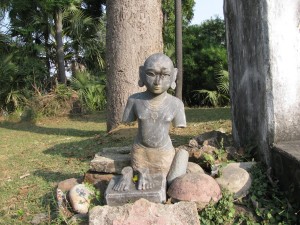 This Place famous for the confluence of Punpun river and Adri river. It is a beautiful scenic peace zone area surrounded by trees all around. Very ancient temples of lord Shiva, Vishnu and Goddess are still here as attraction.
This Place famous for the confluence of Punpun river and Adri river. It is a beautiful scenic peace zone area surrounded by trees all around. Very ancient temples of lord Shiva, Vishnu and Goddess are still here as attraction.
Devi Mandir (Obra):-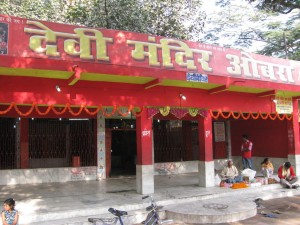 It is situated at kranti chowk. A very spiritual place for the entire region. Nine incarnation of Goddess durga are situated here with temples of Lord Shiva and Hanuman. People have faith here for the fulfillment of their beliefs.
It is situated at kranti chowk. A very spiritual place for the entire region. Nine incarnation of Goddess durga are situated here with temples of Lord Shiva and Hanuman. People have faith here for the fulfillment of their beliefs.
Sahid Jagapati Smarak(Obra):- Late Jagapati is a commemorate for young freedom fighter for Indian Independence, who sacrificed his life to nation in 1942 at the secretariat.He was born in kharati village. near Obra.
Manora :– Lord Buddha stayed here for consecutively 3 days.also famous for Hindu and Buddha temples.
Manora sarif dargah:-
Sun Temple (Kara):- It is situated 6km away from Obra and 23km away from district headquarter Aurangabad. Kara village has an ancient tank with temple of Sun God. It is said that it is erected in 166-67.
Ramnagar:- The KP Jayaswal Research Institute, during in the course of its Archaeological Explorations brought to light the site period NBPW phase. Malwan:- The KP Jayaswal Research Institute, during in the course of its Archaeological Explorations brought to light the site period Early medieval. Dihuri:- The KP Jayaswal Research Institute, during in the course of its Archaeological Explorations brought to light the site period Early medieval. Marowa (Bazidpur):- The KP Jayaswal Research Institute, during in the course of its Archaeological Explorations brought to light the site period Early medieval. Khudwan garh:- The KP Jayaswal Research Institute, during in the course of its Archaeological Explorations brought to light the site period NBPW phase. Ubgarh:- The KP Jayaswal Research Institute, during in the course of its Archaeological Explorations brought to light the site period NBPW phase. Lalarogarh:- The KP Jayaswal Research Institute, during in the course of its Archaeological Explorations brought to light the site period Early medieval. Nauner:- The KP Jayaswal Research Institute, during in the course of its Archaeological Explorations brought to light the site period Early medieval. Mahadeva:- The KP Jayaswal Research Institute, during in the course of its Archaeological Explorations brought to light the site period Early medieval.
Deokali Shiva Mandir :-
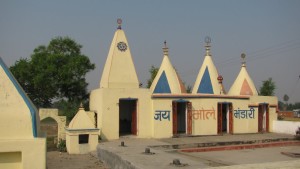 According to Jayaswal Research Institute Archaeological Explorations this site belongs to Early medieval period.
According to Jayaswal Research Institute Archaeological Explorations this site belongs to Early medieval period.
Sadipur Dihri:- The KP Jayaswal Research Institute, during in the course of its Archaeological Explorations brought to light the site period Late medieval. Labadna:- The KP Jayaswal Research Institute, during in the course of its Archaeological Explorations brought to light the site period Late medieval. Mahthu:- The KP Jayaswal Research Institute, during in the course of its Archaeological Explorations brought to light the site period NBPW phase. Bhatauliya Garh:- The KP Jayaswal Research Institute, during in the course of its Archaeological Explorations brought to light the site period Early medieval. Jamuhara:- The KP Jayaswal Research Institute, during in the course of its Archaeological Explorations brought to light the site period Early medieval. Kajhwan:- The KP Jayaswal Research Institute, during in the course of its Archaeological Explorations brought to light the site period Late medieval. Gortara:- The KP Jayaswal Research Institute, during in the course of its Archaeological Explorations brought to light the site period Early medieval. Dikra:- The KP Jayaswal Research Institute, during in the course of its Archaeological Explorations brought to light the site period Medieval. Raipura:- The KP Jayaswal Research Institute, during in the course of its Archaeological Explorations brought to light the site period Early medieval. Takiya:– The KP Jayaswal Research Institute, during in the course of its Archaeological Explorations brought to light the site period Early medieval.
DAUDNAGAR BLOCK
Sun Temple (Shamshernagar):- The Sun Temple of Shamshernagar is recent in origin but the village had a ancient pond. The village is also known as Mayur, named after Sanskrit poet Mayurbhatha of Harshavardhana time( 700A.D) who was a devout worshipper of Sun God
Khanqah Quadria Razzaqula Hammadia (Old Town,Daudnagar):-
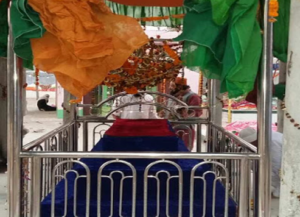 It is abode of an ancient mazaar (grave) of a Muslim saint Hazrat Syed Shah Hammad Ahmad Sabir Quadri R.A
It is abode of an ancient mazaar (grave) of a Muslim saint Hazrat Syed Shah Hammad Ahmad Sabir Quadri R.A
Sahab E Sajjada:-
Syed Shah Waliullah Ahmad Zaya Quadri mada zillahul aali
Khanqah Abdalia Sulaimania Rashidia:- It is situated on Mohalla Minya Sahabka , Olt Town Daudnagar.It is abode of an ancient mazaar (grave) of a Muslim saint Hazrat Syed Shah Anis Ahmad quadri R.A Almaroof ANIS E BEKASAN
Sahab E Sajjada:-
Syed Shah Waliullah Ahmad Zaya Quadri mada zillahul aali
Tomb o f Shamsher Khan(Shamshernagar):-
Tarar:- The KP Jayaswal Research Institute, during in the course of its Archaeological Explorations brought to light the site period Early medieval. Daudnagar:- The KP Jayaswal Research Institute, during in the course of its Archaeological Explorations brought to light the site period Medieval.
Daud Khan Fort:-
This fort is situated on the eastern bank of the Sone River. It was founded by Daud Khan, a Governor of Bihar under Aurangzeb in the 17th of Palamu fort from the Cheros. It is said that while back from this conquest he camped here and founded the town known after him. The surrounding area was also granted to him as a Jagir by the emperor. Early in the 18th century Buchanan saw it as a flourishing town with cloth and opium factories. The sarai built by Daud Khan was, perhaps really meant to be a stronghold; for it was well fortified with a battlemented wall, two large gates and a moat all around. It was called as a sarai probably to avoid jealousy of the Government. The sarai was in good condition till a few years before 1896; for the Bengal list says that the gates were regularly shut every night. Ahmad Khan, grandson of Daud Khan, fortified the town which was then named as Ghausipur. The town also contains an old mosque and another sarai built by Ahmad Khan, which had mud gates. In the outlying part of the town called Ahmedganj is the tomb of Ahmad Khan.
Makhara:- The KP Jayaswal Research Institute, during in the course of its Archaeological Explorations brought to light the site period Early medieval. Gobardhanpur Kanap:– The KP Jayaswal Research Institute, during in the course of its Archaeological Explorations brought to light the site period NBPW phase. Angarahi:- The KP Jayaswal Research Institute, during in the course of its Archaeological Explorations brought to light the site period Medieval. Naini Garh (Nonar):- The KP Jayaswal Research Institute, during in the course of its Archaeological Explorations brought to light the site period Early medieval. Chauri (Dhanhara):- The KP Jayaswal Research Institute, during in the course of its Archaeological Explorations brought to light the site period Early medieval. Arai Garh:– The KP Jayaswal Research Institute, during in the course of its Archaeological Explorations brought to light the site period Early medieval. Belawan:- The KP Jayaswal Research Institute, during in the course of its Archaeological Explorations brought to light the site period Medieval. Chauram:- The KP Jayaswal Research Institute, during in the course of its Archaeological Explorations brought to light the site period NBPW phase.
Chauram Ashram of Kumar Badri Narayan Singh:- During the freedom movement of 20th .Century, the people of this region also took active part and remained in close contact of freedom fighters of the whole country. Mahatma Gandhi also came here. Hundred of persons joined the freedom movement, leaving their own profession at his call. Kumar Badari Narayan Singh led the Namak Satyagraha of 1930. Lok Nayak Jai Prakash Narayan got shelter here after fleeing away from Hazaribagh Jail. Netaji Subhash Chandra Bose also stayed here for few days.
Adampur Garh (Tarari):- The KP Jayaswal Research Institute, during in the course of its Archaeological Explorations brought to light the site period Medieval. Manar:- The KP Jayaswal Research Institute, during in the course of its Archaeological Explorations brought to light the site period Medieval. Anchchha:- The KP Jayaswal Research Institute, during in the course of its Archaeological Explorations brought to light the site period Early medieval.
Agnur (Dhadhichan Bigha) (25:5’E::84:24’ N):- The site is located 8 kms north of Daudnagar.The site is a hydroelectric power project of the state government on the river Son. An aggregate installed capacity of 1.0 MW are in operation. Commissioned in year 2006. Beauty of small colonial township between haphazard village establishment attracts tourist eyes. Besides, it has constructional aspects of hydroelectric projects like dam overflow sluice gates etc to show to the visitors.
Kanap Sun Temple:-
A old and historical temple of god sun which is called SURYA MANDIR. A very old and historical temple of shree Ram and Sita is which is called GARH, it is in the middle of the village.
DEO BLOCK
Kataiya Garh:- The KP Jayaswal Research Institute, during in the course of its Archaeological Explorations brought to light the site period Early medieval. Ketaki Garh:- The KP Jayaswal Research Institute, during in the course of its Archaeological Explorations brought to light the site period Early medieval. Bedana Garh:- The KP Jayaswal Research Institute, during in the course of its Archaeological Explorations brought to light the site period NBPW phase. Baranda:- The KP Jayaswal Research Institute, during in the course of its Archaeological Explorations brought to light the site period Early medieval. Banua Garh:- The KP Jayaswal Research Institute, during in the course of its Archaeological Explorations brought to light the site period Early medieval. Bishnupur Chatti:- The KP Jayaswal Research Institute, during in the course of its Archaeological Explorations brought to light the site period Medieval. Pachaukhar:- The KP Jayaswal Research Institute, during in the course of its Archaeological Explorations brought to light the site period Medieval. Panchmunh Garh:- The KP Jayaswal Research Institute, during in the course of its Archaeological Explorations brought to light the site period Early medieval. Bedani Garh:- The KP Jayaswal Research Institute, during in the course of its Archaeological Explorations brought to light the site period Medieval.
Deo:- The KP Jayaswal Research Institute, during in the course of its Archaeological Explorations brought to light the site period Early medieval.
Deo Sun temple :-
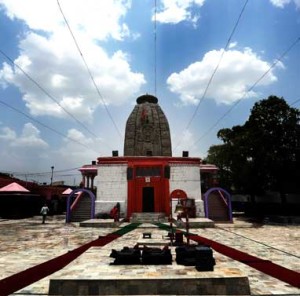
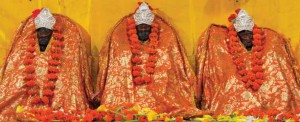 It is located 10-km to the southeast of Aurangabad on the road Deo more to Deo, Deo is home to the well-known Sun temple of konark style . The 15th century old temple is believed to be built by Bhairvendra Sing, a Chandravanshi king of Umga. It is a 100-ft tall structure, with an umbrella-like top. The old statue of the Sun was broken by Mogul rulers during their regime. The statue of trikal Surya has been established. The temple surprisingly faces the West, unlike traditional Sun temples which face the East. An interesting legend explains this- His might being challenged by Muslim invaders, the Sun God turned His face to the West to save the honour of His faithful devotees.
It is located 10-km to the southeast of Aurangabad on the road Deo more to Deo, Deo is home to the well-known Sun temple of konark style . The 15th century old temple is believed to be built by Bhairvendra Sing, a Chandravanshi king of Umga. It is a 100-ft tall structure, with an umbrella-like top. The old statue of the Sun was broken by Mogul rulers during their regime. The statue of trikal Surya has been established. The temple surprisingly faces the West, unlike traditional Sun temples which face the East. An interesting legend explains this- His might being challenged by Muslim invaders, the Sun God turned His face to the West to save the honour of His faithful devotees.
The important custom of worshipping the Sun God and taking bath in its Brahma Kund dates back to the era of King Ayel. In Deo the King Aila of Prayaga (Allahabad) was cured of leprosy. There is myth that the descendent of Maharana Pratap. Raja Fateh Narayan Singh, who was a leper, came here in course of hunting to quench the thirst of his horse, he fell in that “kund”. It is said that he became cure of it . His disease of leprosy disappeared.The People of this region pay oblation to him especially on Sunday; Surya Shashti of month Chaitra, during the Adra Nakshatra and on Surya Shashti (Chhath festival) of month of Kartik of Hindu Calendar . People of this district and nearby districts treat Sun god as PRATYACHHA DEVTA (Visible God), From whom we human being and all creatures get power .There is also a folk tale that Lord Brahma Started to construct three temples in this region in a single night. Two of them, the temples of Deo and Umga were completed, but third one of Devkund could not be completed, because it became morning, and the crow began to speak .
SUFI RAHIMUDDIN SHAH R.A(BALA POKHAR, Deo):-
KUTUMBA BLOCK
Amba :- It is situated about 16 km from Aurangabad on Nh 98. People of this district and nearby districts treat as Saktipith.
HAZRAT DAUD KAMBAL POSH R.A(BHERIYA):-
Jagdishpur:- The KP Jayaswal Research Institute, during in the course of its Archaeological Explorations brought to light the site period NBPW phase. Ordih:- The KP Jayaswal Research Institute, during in the course of its Archaeological Explorations brought to light the site period Medieval. Dadhpa:– The KP Jayaswal Research Institute, during in the course of its Archaeological Explorations brought to light the site period Early medieval. Chakwa:-The KP Jayaswal Research Institute, during in the course of its Archaeological Explorations brought to light the site period Medieval. Pipra Bagahi:- The KP Jayaswal Research Institute, during in the course of its Archaeological Explorations brought to light the site period Early medieval. Dumarigarh (Dumari Baluganj):- The KP Jayaswal Research Institute, during in the course of its Archaeological Explorations brought to light the site period Early medieval. Mirzapur:- The KP Jayaswal Research Institute, during in the course of its Archaeological Explorations brought to light the site period Early medieval.
Kutumba Garh:- A site offers the remains of fort like structure atop a long mud and stone fortification wall with lime plaster at some place. A modern school has come up amidst the ruins and over the fortification, but there is also large number of antiquities belonging from the chalcolithic age to the Pal age. A state archaeology official who visited the site earlier, has reported a number of northern black polished ware and red ware found lying around the mound scattered and uncared. Kutumba is related with one of king who’s kingdom was not expanded its ruling area in more broader way.
According to Jayaswal Research Institute Archaeological Explorations this site belongs to Mesolithic period.
HAZRAT MANAWWAR KUTUMBWI R.A(KUTUMBA):-
Kalpa tree (Parta):-
GOH BLOCK
Bhurkundaunda:- The KP Jayaswal Research Institute, during in the course of its Archaeological Explorations brought to light the site period Early medieval. Bajalpur:- The KP Jayaswal Research Institute, during in the course of its Archaeological Explorations brought to light the site period Early medieval. Etkohiya:- The KP Jayaswal Research Institute, during in the course of its Archaeological Explorations brought to light the site period Kushan. Marhisthan (Bhurkunda):- The KP Jayaswal Research Institute, during in the course of its Archaeological Explorations brought to light the site period NBPW phase. Jahidpur (Upahra):- The KP Jayaswal Research Institute, during in the course of its Archaeological Explorations brought to light the site period Gupta.Waso Bigha:- The KP Jayaswal Research Institute, during in the course of its Archaeological Explorations brought to light the site period Medieval. Phag Garh:- The KP Jayaswal Research Institute, during in the course of its Archaeological Explorations brought to light the site period NBPW phase. Bantara:- The KP Jayaswal Research Institute, during in the course of its Archaeological Explorations brought to light the site period Medieval. Arand:- The KP Jayaswal Research Institute, during in the course of its Archaeological Explorations brought to light the site period Late medieval. Prasi:- The KP Jayaswal Research Institute, during in the course of its Archaeological Explorations brought to light the site period Early medieval. Mahadeo Bigha (Teap):- The KP Jayaswal Research Institute, during in the course of its Archaeological Explorations brought to light the site period Medieval. Mosumabad (Gorkatti):– The KP Jayaswal Research Institute, during in the course of its Archaeological Explorations brought to light the site period Gupta. Mujahara:- The KP Jayaswal Research Institute, during in the course of its Archaeological Explorations brought to light the site period Medieval. Malhad:- The KP Jayaswal Research Institute, during in the course of its Archaeological Explorations brought to light the site period Early medieval. Harigaon:- The KP Jayaswal Research Institute, during in the course of its Archaeological Explorations brought to light the site period Early medieval. Baksar:-The KP Jayaswal Research Institute, during in the course of its Archaeological Explorations brought to light the site period Early medieval. Dadar:- The KP Jayaswal Research Institute, during in the course of its Archaeological Explorations brought to light the site period Early medieval. Goh:- The KP Jayaswal Research Institute, during in the course of its Archaeological Explorations brought to light the site period Chalcolithic. Barman:- The KP Jayaswal Research Institute, during in the course of its Archaeological Explorations brought to light the site period NBPW phase. Deohara:– The KP Jayaswal Research Institute, during in the course of its Archaeological Explorations brought to light the site period Early medieval.
Marhi Dham:- It is ancient statue of Maa Siwahini.
Nakti Bhawani :- It is situated at the junction of river Punpun and Madar near Sheikhupura village.The sages Bhrigu practiced penance here .The deity of sage Bhrigu, Bhavani’s statue is still in existence. The nose of the said statue is broken . As such, the people of that region call her Nakti Bhawani.The celebrated book of Indian Astrology Bhrigu Sanhita was written there .
Bujurg Shekhpura:- The KP Jayaswal Research Institute, during in the course of its Archaeological Explorations brought to light the site period Early medieval. Bhrigurari:- The KP Jayaswal Research Institute, during in the course of its Archaeological Explorations brought to light the site period NBPW phase. Anwari:- The KP Jayaswal Research Institute, during in the course of its Archaeological Explorations brought to light the site period Early medieval. Tole Dular Bigha:- The KP Jayaswal Research Institute, during in the course of its Archaeological Explorations brought to light the site period Early medieval. Mohiuddinpur:– The KP Jayaswal Research Institute, during in the course of its Archaeological Explorations brought to light the site period Medieval. Dihuri:- The KP Jayaswal Research Institute, during in the course of its Archaeological Explorations brought to light the site period Early medieval. Motha:- The KP Jayaswal Research Institute, during in the course of its Archaeological Explorations brought to light the site period Medieval. Jamuain:- The KP Jayaswal Research Institute, during in the course of its Archaeological Explorations brought to light the site period Early medieval. Dadhpi:- The KP Jayaswal Research Institute, during in the course of its Archaeological Explorations brought to light the site period Medieval. Saraiya:- The KP Jayaswal Research Institute, during in the course of its Archaeological Explorations brought to light the site period Early medieval. Chapuk:- The KP Jayaswal Research Institute, during in the course of its Archaeological Explorations brought to light the site period Early medieval. Pali:- The KP Jayaswal Research Institute, during in the course of its Archaeological Explorations brought to light the site period NBPW phase. Barman Khurd:- The KP Jayaswal Research Institute, during in the course of its Archaeological Explorations brought to light the site period NBPW phase. Ghanto:-The KP Jayaswal Research Institute, during in the course of its Archaeological Explorations brought to light the site period Medieval.
Sun Temple(Nimbahitanr ):-
The temple is erected in late Medieval period.
MADANPUR BLOCK
Cahalo Pokhar:- It is situated south of Aurangabad near 7 km north of Madanpur which is on NH-2
Aat Manika:- The KP Jayaswal Research Institute, during in the course of its Archaeological Explorations brought to light the site period Medieval.
Umaga Pahar (Umga) :- Located 24-km to the east of the Aurangabad city just near south of Madanpur on NH- 2. Temple renovated by the king Bhairavendra of Umaga hill in 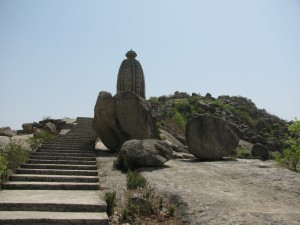 sixth century. The temple bears resemblance to the Sun temple built at Deo. Square granite blocks are used to built the magnificent temple, which houses the deities of Lord Ganesha, Sun God and Lord Shiva. The hill of Umga is full of temples, where so many statues of different gods and goddesses are scattered.
sixth century. The temple bears resemblance to the Sun temple built at Deo. Square granite blocks are used to built the magnificent temple, which houses the deities of Lord Ganesha, Sun God and Lord Shiva. The hill of Umga is full of temples, where so many statues of different gods and goddesses are scattered.
Fifty two bighas of the pond of the king, Birendra of Umaga of the sixth century, the well, standing on the Rani Ghat hill, the Bawan temple on the mountain are the symbolic of our prowess and self-respect. The ruins of Maa Sati Chandi, Satavahana, Sita, Thapa, Hari Yahi Dame on the river , Batane, the forts of Deo, Kara Nawab, various buildings and ancient temples are available even today in this district.
According to Jayaswal Research Institute Archaeological Explorations this site belongs to Early medieval period.
War:- The KP Jayaswal Research Institute, during in the course of its Archaeological Explorations brought to light the site period Early medieval. Chein Nawada:- The KP Jayaswal Research Institute, during in the course of its Archaeological Explorations brought to light the site period Early medieval. Khiriyanwan:- The KP Jayaswal Research Institute, during in the course of its Archaeological Explorations brought to light the site period Early medieval. Bariyawan:- The KP Jayaswal Research Institute, during in the course of its Archaeological Explorations brought to light the site period Early medieval. Beri:- The KP Jayaswal Research Institute, during in the course of its Archaeological Explorations brought to light the site period Early medieval. Sirmaur Garh (Dehuli):- The KP Jayaswal Research Institute, during in the course of its Archaeological Explorations brought to light the site period Early medieval. Shiva Bigha Dihwar Asthan:- The KP Jayaswal Research Institute, during in the course of its Archaeological Explorations brought to light the site period Early medieval. Jaypal Bigha Nadi Tat:- The KP Jayaswal Research Institute, during in the course of its Archaeological Explorations brought to light the site period Medieval. Manika Garh:- The KP Jayaswal Research Institute, during in the course of its Archaeological Explorations brought to light the site period Early medieval. Aajan Garh:- The KP Jayaswal Research Institute, during in the course of its Archaeological Explorations brought to light the site period NBPW phase. Prem Nagar:- The KP Jayaswal Research Institute, during in the course of its Archaeological Explorations brought to light the site period Early medieval. Madanpur:- The KP Jayaswal Research Institute, during in the course of its Archaeological Explorations brought to light the site period Medieval. Nawada Garh:- The KP Jayaswal Research Institute, during in the course of its Archaeological Explorations brought to light the site period Early medieval.
HASPURA BLOCK
Munjahar:- The KP Jayaswal Research Institute, during in the course of its Archaeological Explorations brought to light the site period Chalcolithic. Kaithi Bankat:- The KP Jayaswal Research Institute, during in the course of its Archaeological Explorations brought to light the site period Early medieval. Koilawan Shivasthan:- The KP Jayaswal Research Institute, during in the course of its Archaeological Explorations brought to light the site period NBPW phase. Tal:- The KP Jayaswal Research Institute, during in the course of its Archaeological Explorations brought to light the site period Early medieval. Mahuar:- The KP Jayaswal Research Institute, during in the course of its Archaeological Explorations brought to light the site period Early medieval. Jhinguri:- The KP Jayaswal Research Institute, during in the course of its Archaeological Explorations brought to light the site period Early medieval. Dindor:- The KP Jayaswal Research Institute, during in the course of its Archaeological Explorations brought to light the site period Early medieval. Baghoi:- The KP Jayaswal Research Institute, during in the course of its Archaeological Explorations brought to light the site period NBPW phase. Narhana (Ramjivan Bigha):- The KP Jayaswal Research Institute, during in the course of its Archaeological Explorations brought to light the site period Chalcolithic. Sonhathu:- The KP Jayaswal Research Institute, during in the course of its Archaeological Explorations brought to light the site period Early medieval. Dhamani:- The KP Jayaswal Research Institute, during in the course of its Archaeological Explorations brought to light the site period Early medieval. Bihta:– The KP Jayaswal Research Institute, during in the course of its Archaeological Explorations brought to light the site period Late medieval. Dihuri:- The KP Jayaswal Research Institute, during in the course of its Archaeological Explorations brought to light the site period Late medieval. Chanhat:- The KP Jayaswal Research Institute, during in the course of its Archaeological Explorations brought to light the site period Early medieval. Itawa:- The KP Jayaswal Research Institute, during in the course of its Archaeological Explorations brought to light the site period Early medieval. Itawa Bazirpur:– The KP Jayaswal Research Institute, during in the course of its Archaeological Explorations brought to light the site period Early medieval. Itawa Jalalpur:- The KP Jayaswal Research Institute, during in the course of its Archaeological Explorations brought to light the site period Early medieval. Sihari:- The KP Jayaswal Research Institute, during in the course of its Archaeological Explorations brought to light the site period Late medieval. Barokhar:– The KP Jayaswal Research Institute, during in the course of its Archaeological Explorations brought to light the site period Early medieval. Gahana:- The KP Jayaswal Research Institute, during in the course of its Archaeological Explorations brought to light the site period Early medieval. Paharpur:- The KP Jayaswal Research Institute, during in the course of its Archaeological Explorations brought to light the site period Late medieval.
Amajharsharif:-
It is located about 10 km away from Panchrukhi, on the Daudnagar-Gaya Road, Amjhar Sharif is abode of an ancient mazaar (grave) of a Muslim saint – Hazrat Syedna Mohammad Jilani Amjhari Quadri. Thousands of Muslims visit this pilgrimage center on the anniversary of the great saint, which is held in the first week of June. The holy hair of the saint is put on display on the occasion.
Amajharsharif is also known chhoti Dargaah.
According to Jayaswal Research Institute Archaeological Explorations this site belongs to Early medieval period
Manpura:- The KP Jayaswal Research Institute, during in the course of its Archaeological Explorations brought to light the site period Early medieval. Chahuta:- The KP Jayaswal Research Institute, during in the course of its Archaeological Explorations brought to light the site period Early medieval. Jaitpur:- The KP Jayaswal Research Institute, during in the course of its Archaeological Explorations brought to light the site period Early medieval.
Piru:- It is situated km of Aurangabad, bears some historical significance. It is believed to be Pritikoota in the ancient times, it was the birthplace of Banbhatta, a legendary poet and the State Chronicler of King Harshwardhana.Celebrated books of Sanskrit literature KADAMBARI AND HARSHCHARITRA were written by Banbhatta.So many manuscripts written on Bhojpatra and Talapatra of that regime are being preserved village piru in the Banabhatta Pustakalaya of the same village.
According to Jayaswal Research Institute Archaeological Explorations this site belongs to Early medieval period .
Jakhaura:- The KP Jayaswal Research Institute, during in the course of its Archaeological Explorations brought to light the site period Early medieval. Barewa (Chiraiya Tand):- The KP Jayaswal Research Institute, during in the course of its Archaeological Explorations brought to light the site period Early medieval. Barokhar Dih:- The KP Jayaswal Research Institute, during in the course of its Archaeological Explorations brought to light the site period Chalcolithic. Rampur Kaithi:- The KP Jayaswal Research Institute, during in the course of its Archaeological Explorations brought to light the site period Medieval. Dhamni:- The KP Jayaswal Research Institute, during in the course of its Archaeological Explorations brought to light the site period Chalcolithic. Kishunpur (Bandhu Bigha):- The KP Jayaswal Research Institute, during in the course of its Archaeological Explorations brought to light the site period Early medieval. Raipur Bandhawa:- The KP Jayaswal Research Institute, during in the course of its Archaeological Explorations brought to light the site period Early medieval. Ratanpur Dhibara:- The KP Jayaswal Research Institute, during in the course of its Archaeological Explorations brought to light the site period NBPW phase. Malhara;- The KP Jayaswal Research Institute, during in the course of its Archaeological Explorations brought to light the site period Early medieval.
Devkund ( Baba Dudheshwar Nath)(Rishi Chaywan’s Ashram):- It is situated in village Deo Kund which is 45 km to the north – east of Aurangabad in Haspura block on the border of Aurangabad and Jehanabad, 12 km from Goh at SH -68 .
According to Hindu mythology, once Lord Vishwakarma was told to make three temples in one night. These three temples are identical in design and incorporates a small pond with it. The only difference is the absence of fourth side wall of the pond at Devkund, which Lord Vishwakarma could not complete as the Sunrise occurred.In modern times those three temples are located at Deo, Deokund and Umga in Bihar. Two of these three towns i.e.Deo & Umaga have Sun temples and Deokund has Lord Shiva temple. About 500 years ago this was the penance place of Rishi Chyawan. The site is recognised as mediation region of Chyawan Rishi. Here he got his eyes damaged accidentally by princess Sanyukta who later became his wife. Ashwini Kumar came here and blessed the rishi and gave him the formula of ChyavanPrash. The shivling which he made out of Kasauti stone (touchstone) is still here and is called Chaywaneshwar Shivling and the temple was created by Lord Vishwakarma in one night.The famous Chhath festival of Bihar originated from here as his wife started observing it for the first time.
The Ashram of sage Chyawan is still a remainder Akhand Dhuni (A place where the Saint used to continuously burn a log) of sage Chyawan is still in existence, Where fire was not lit again.
The Samadhi of Bal Yogi is also in front of Akhand Dhuni. People of this region still come in front of that, Samadhi and sit there to settle their disputes .They believe that the soul of the said yogi is still alive and he gives justice. As such the people of this region take an oath before him and leave their disputes to Balyogi.The people of this region save faith that justice will be done sure. Thus disputes are settled here ever in the present age.
According to Jayaswal Research Institute Archaeological Explorations this site belongs to Early medieval period.
